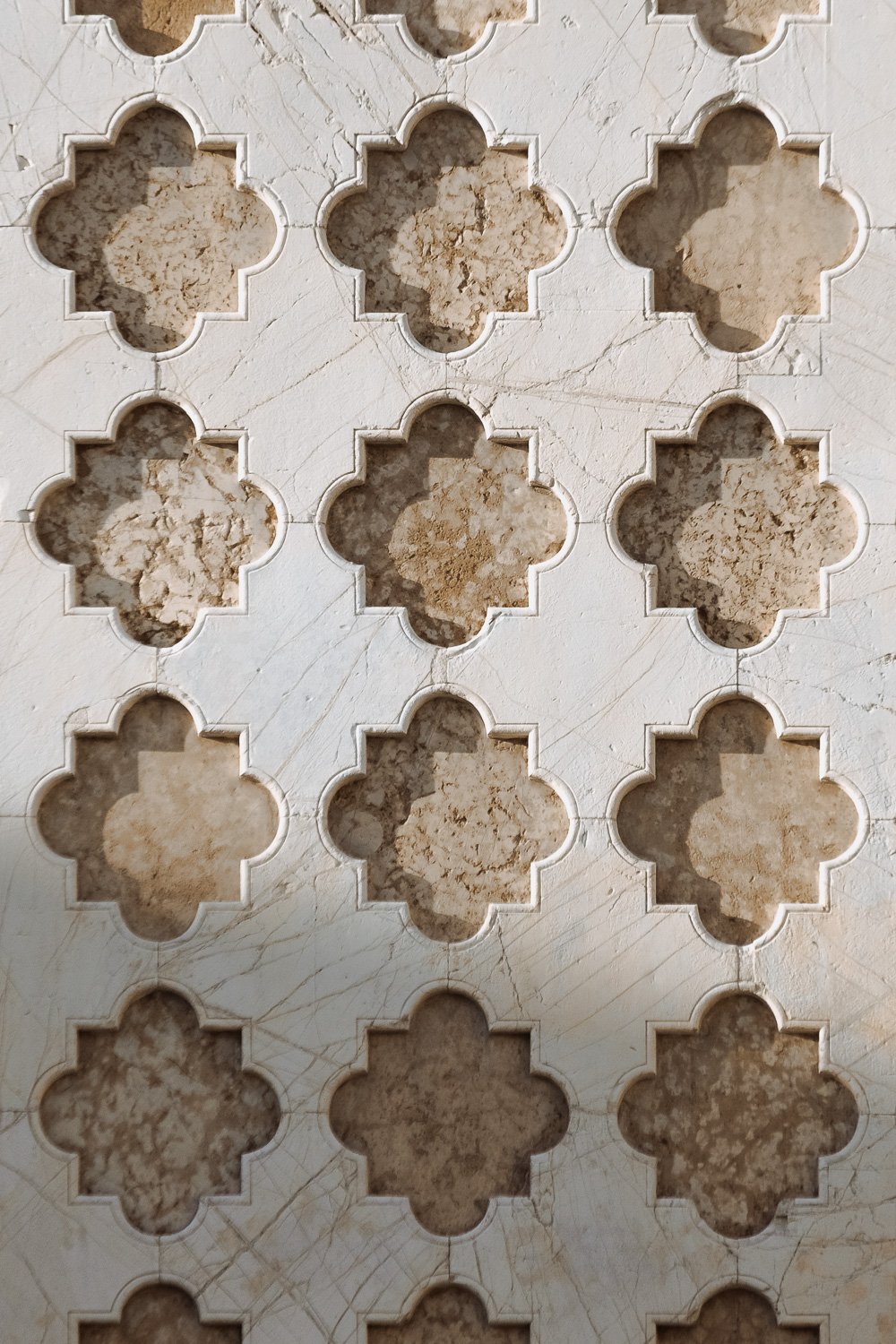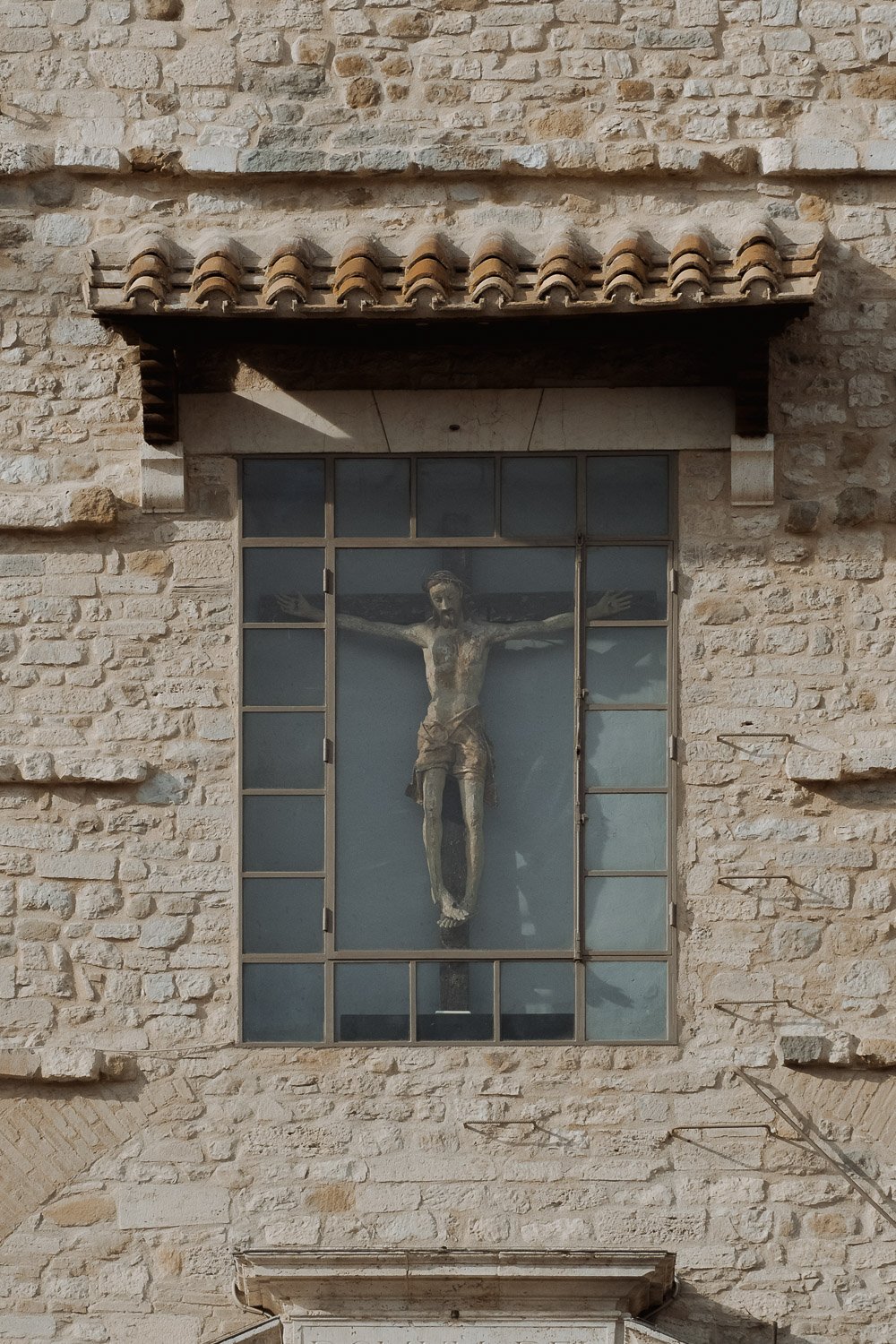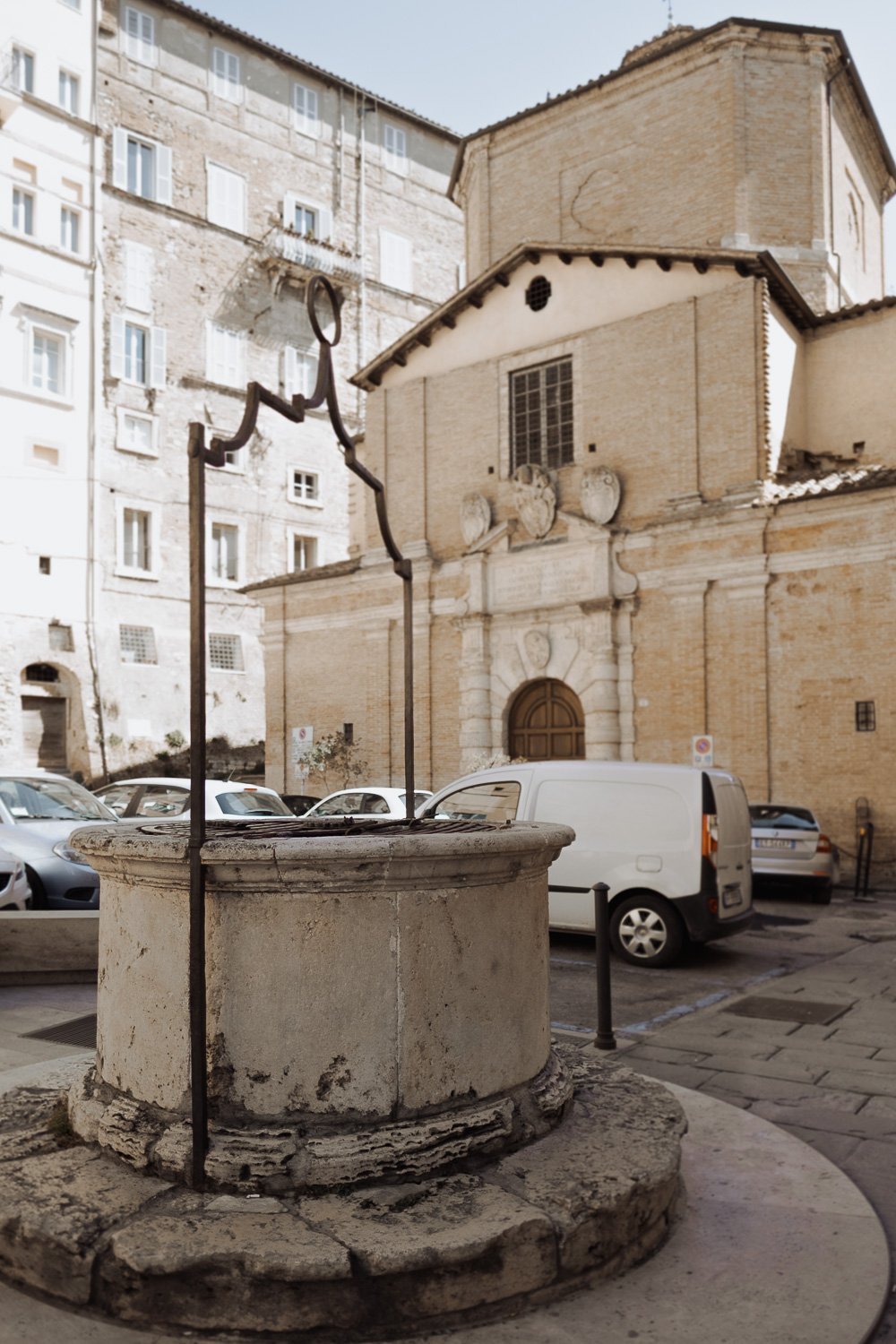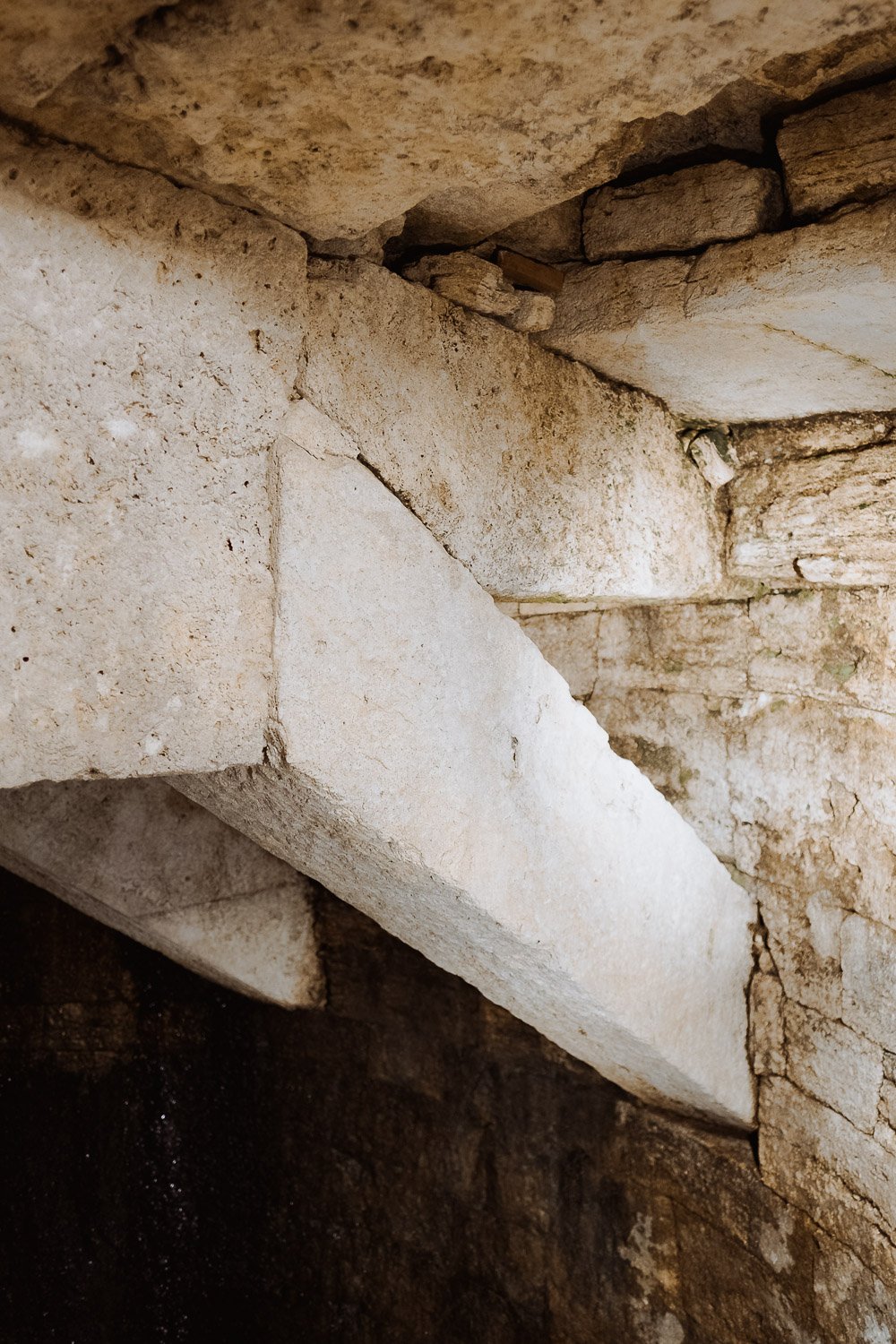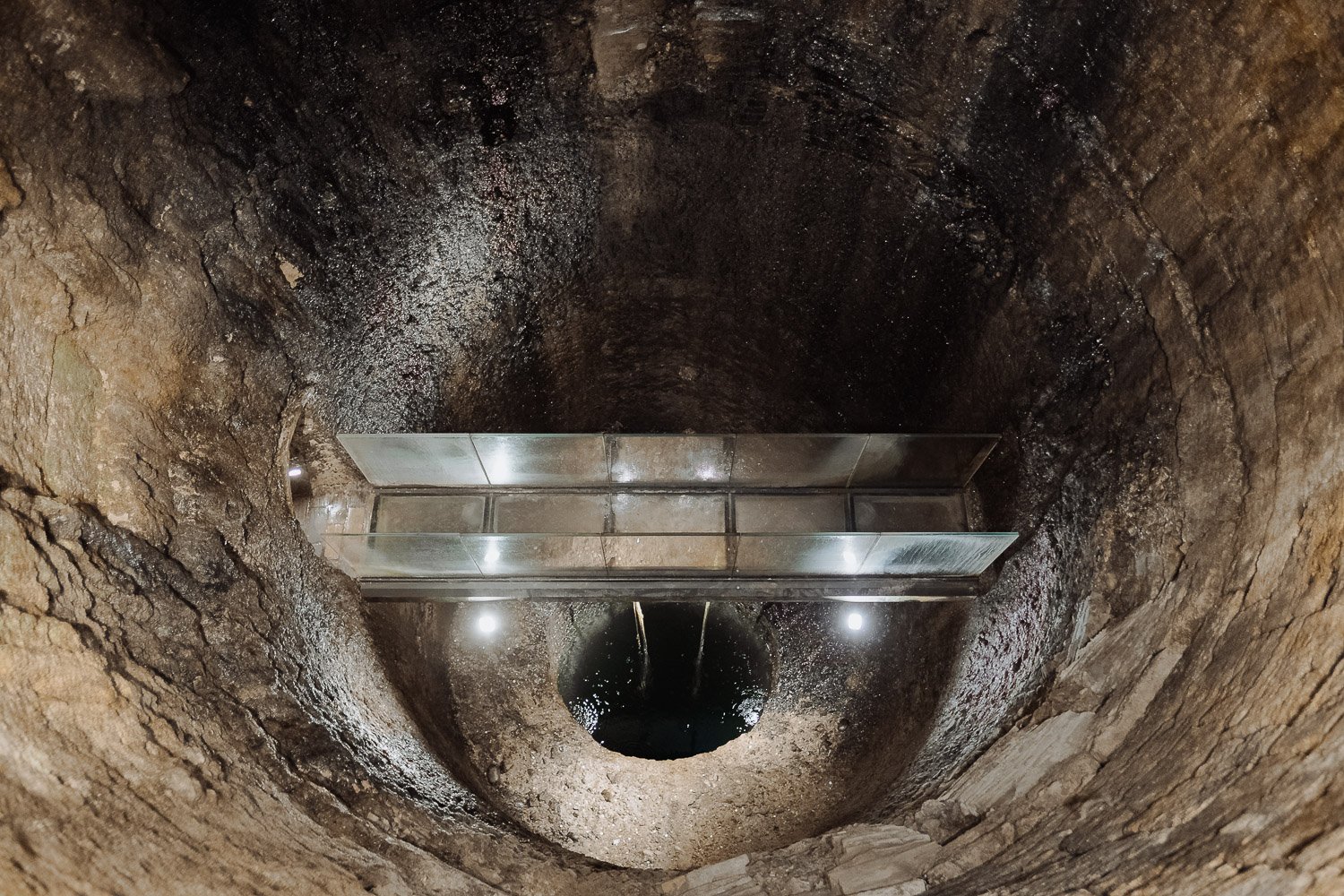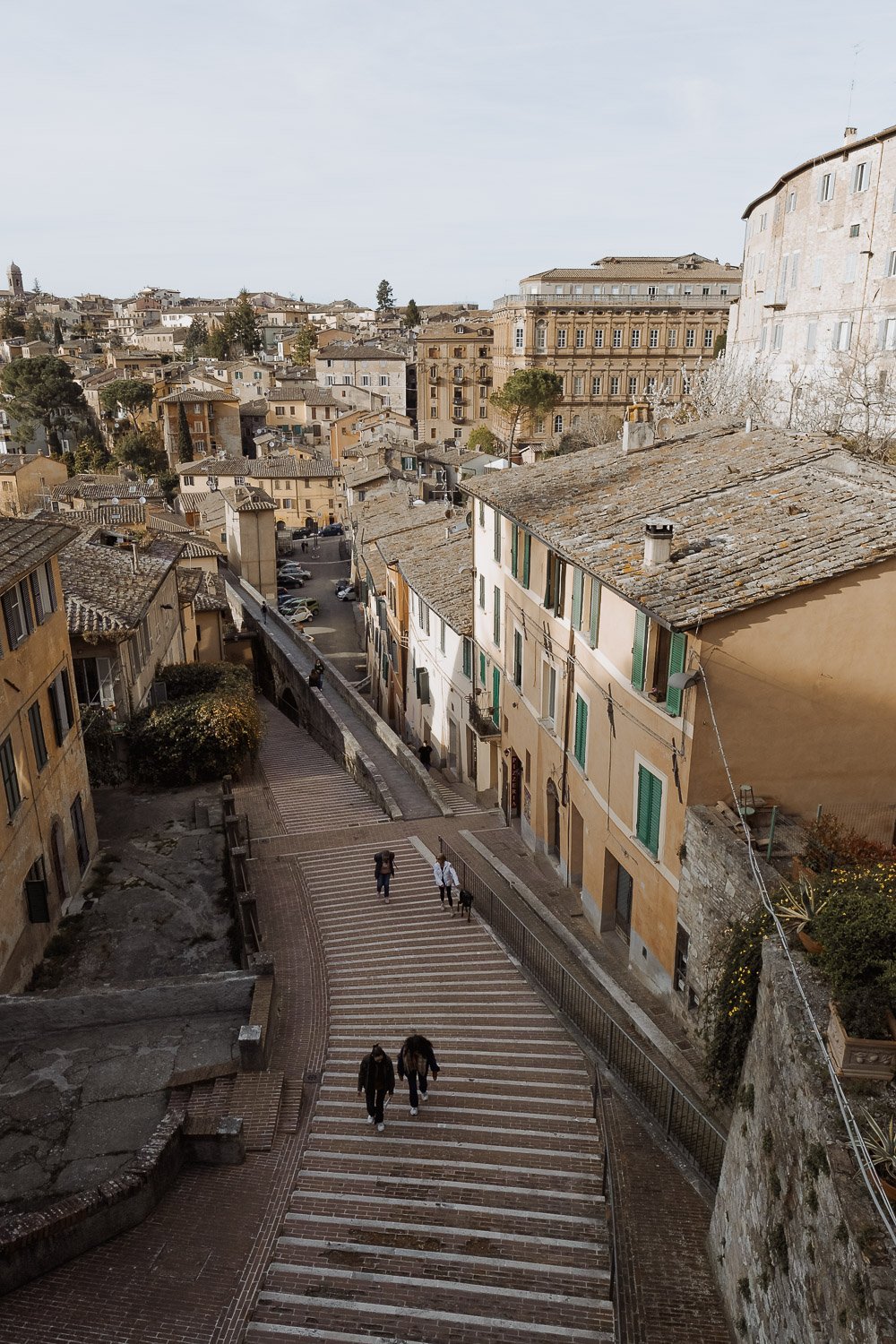Perugia: top 15 things to do
Perugia: the perfect starting point when you visit Umbria. With more than 165,000 inhabitants, it is the largest city in the region, as well as its capital. Yet it is a relatively compact city. All sights can easily be visited on foot. And believe me, there are many! From one of the oldest churches in Italy to people-watching in medieval squares, Perugia has a lot to offer. The best way to discover the city is to stay at least 2 or 3 days.
Image text
If you like good food, Perugia is also the right place for you. And then I haven't even mentioned their chocolate yet. Did you know that the famous Baci chocolates (Italian for 'kiss') come from Perugia? For those who don't know the story behind the chocolates: rumor has it that the young chocolatier Luisa Spagnoli fell in love with Giovanni Buitoni, one of the founders of the Perugina chocolate company. To communicate with her lover, Luisa wrapped handwritten secret messages around chocolates. Today, 100 years later, Perugina continues this tradition. This makes their chocolates one of the most popular gifts on Valentine's Day.
But enough about chocolate and let's discover Perugia! Based on my most recent stay, I've made a list of the 15 best things to see and do during your stay. I'd love to hear which one you liked the most!
If you are planning to stay in Perugia for a week or so: the city is also a perfect home base to explore the rest of Umbria. How about a day trip to Lago Trasimeno, Gubbio, or one of the other nearby medieval towns?
#1 Piazza IV Novembre
The best place to start your visit to Perugia is Piazza IV Novembre. Since early history, this square served an important role. It marked the intersection of the main roads of the ancient city: the Cardo Maximus (from Arco di Augusto in the north to Porta Marzia in the south) and the Decumanus Maximus (from Porta Trasimena in the west to Arco dei Gigli in the east). As in many other cities, the Romans built their Roman Forum on the intersection of the two roads.
Image text
The focal point of the square is the Fontana Maggiore. This iconic fountain was built between 1275 and 1278 to celebrate the arrival of water in the city center through Perugia's aqueduct.
Nicola Pisano and his son Giovanni were asked to design 48 reliefs to decorate the fountain. Twelve of them represent the months of the year, accompanied by their zodiac sign. In between, they placed scenes depicting Roman legends, the fables of Aesop, the lives of saints, personifications of the sciences and the arts.
Image text
Nicola and Giovanni also made 24 statues for the upper basin. The statues represent saints and mythological and biblical characters from the New and Old Testament.
Around the Fontana Maggiore a Latin inscription is carved, beginning with: “Guarda tu che passi questalieto mormorio, se osservi bene puoi vedere cose mirabili”. Look, you who pass by this fountain with its happy murmuring; if you look closer, you can see wonderful things. It refers not only to the fountain itself but also to the magnificent aqueduct.
#2 Palazzo dei Priori
One of the most striking buildings on Piazza IV Novembre is Palazzo dei Priori. You can recognize this building by the bronze statues of a griffin and a lion above the entrance. The griffin is the symbol of the city of Perugia, and the lion is the symbol of the Guelphs. This was the faction that sided with the pope during the famous feuds. Both statues above the portal are modern copies. The original ones are placed inside, to the left of the entrance to the Galleria Nazionale.
Image text
But, back to the Palazzo. Palazzo dei Priori was built in several phases between 1293 and 1443. It is one of the most important examples of Gothic architecture in Italy. The building takes its name from the Priori. This was the highest political authority, who governed the city in the medieval era. Today part of the Palazzo (first floor) is still home to the Municipality of Perugia.
On the first floor, you will also find the Sala dei Notari. You can reach the hall by taking the stairway at Piazza IV Novembre. The Sala dei Notari is the oldest part of the building and once the office of the mighty guild of the notaries. The hall is characterized by eight arches decorated with colorful frescoes. They represent the fables of Aesop, legends, and biblical stories.
Image text
Behind the Sala dei Notari is the Sala del Malconsiglio, or Hall of Bad Advice (not accessible for the public). The hall was named so because around 1360, the city officials decided to release several prisoners. Among them was Sir John Hawkwood and his mercenaries. The year after they were released, they defeated Perugia at the Battle of Ponte San Giovanni.
Open: Tue - Sun 9:30 to 13:00 / 15:00 to 19:00, closed on Mondays
Entry fees: Entrance to the Sala dei Notari is free
#3 Galleria Nazionale dell'Umbria
The top two floors of Palazzo dei Priori house the Galleria Nazionale dell'Umbria. This museum has the richest collection of works of art in Umbria. You can reach the Galleria via the Portale Maggiore on Corso Vannucci. This richly decorated entrance cannot be overlooked. When standing in front of it, don't forget to look up. You will then see two griffins above the gate. Each of them with a calf in their claws. Calves are the symbol of the guild of butchers, who paid for the work.
Another interesting detail can be seen at the top left of the entrance. One of the characters holds a piece of parchment that reads "Entra puro, move securo". This can be translated as: enter in purity of intentions and walk safely.
Image text
The permanent collection inside the museum is chronologically ordered. It features a wealth of important medieval and Renaissance works by artists as Nicola and Giovanni Pisano, Giovanni Boccati, and Pintoricchio.
With 40 exhibition rooms, the Galleria Nazionale dell'Umbria is a must on your itinerary if you love (religious) Renaissance art. If not, I would suggest you simply admire the building's exterior and just visit the (free) Sala dei Notari.
Image text
Image text
Open: Wed - Fri 14:00 to 19:00, Sat - Sun 08:30 to 19:30
Entry fees: Entrance to the museum is €8,-
#4 Cattedrale di San Lorenzo
Opposite Palazzo dei Priori on Piazza IV Novembre you will find Perugia's main church, the Cattedrale di San Lorenzo. The cathedral replaced an older church dating from the 9th century (and later rebuilt in the 12th century). Around 1300 it was decided to expand or replace this church. Construction finally started in 1345, and the completion of the work lasted until 1490. But is the cathedral really finished? Probably not. The raw state of the external facades is a clear sign of unfinished work. An example is the southern facade, where white and rose tiles only cover the lowest section of the wall.
Image text
Completed or not, with the construction of the Cattedrale di San Lorenzo, Piazza IV Novembre became the seat of both political (Palazzo dei Priori) and religious power.
Another thing that stands out from the outside is the wooden crucifix above the entrance. The suffering Christ supposes to represent the 'Salt War' of 1540. In that year, Pope Paul III decided to levy a new tax on salt. This violated treaties between Perugia and previous popes. Legend holds that the people in Perugia responded by no longer putting salt in their bread, making unsalted bread the norm to this day.
Detail of the partly tiled facade (left), wooden crucifix above the entrance (right)
The interior of the church strikes mainly because of its largeness. One of the most famous works in the cathedral is the Deposition of Barocci. The figures in this painting show many distinct emotions, and the use of color links the entire composition together.
The Cattedrale di San Lorenzo also keeps the famous Sant'Anello or Holy Ring. It is said that this is the wedding ring that Joseph of Nazareth gave to the Virgin Mary. The ring can only be admired a few days a year, and unfortunately, I haven't had the chance to yet.
Image text
Open: Mon - Sat 07:30 to 12:00 / 15:30 to 19:00, on Sundays the church opens 30 minutes later, both in the morning and afternoon.
Entry fees: Entrance to the church is free
#5 Pozzo Etrusco
It only takes a 2-minute walk from The Cattedrale di San Lorenzo to reach Piazza Piccinino, where you will find an old well. This visible part of the well dates from the 16th century. However, directly underneath it, there's an ancient Etruscan well that dates back to the 3rd century BC.
Pozzo Etrusco on Piazza Piccinino (left), detail of travertine truss beams that support the superstructure of the well (right)
This Etruscan Well, or Pozzo Etrusco, starts about three meters below the current street level. To visit the ancient well, go to the entrance on Piazza Danti. From there, you can walk up a glass footbridge that spans the diameter of the well, affording an excellent view of its interior. When you look up, you can see that the first part of the well is made of travertine blocks, similar to those used for the city's Etruscan walls. At the very top are large travertine truss beams that support the superstructure of the well (i.e., the street level).
Glass footbridge inside the Pozzo Etrusco
After 12 meters or so, the shaft narrows to about 3 meters and extends to approximately 37 meters below ground level. This makes the Pozzo Etrusco an impressive piece of ancient engineering.
Oh, and if you were wondering, yes, there still is water in the well. This is because it is still fed today by three veins of water.
Open: Mon - Fri 10:00 to 14:00, Sat - Sun 10:00 to 14:00 / 15:00 - 17:30
Entry fees: Entrance to the well is €3,-
#6 Via dell'Acquedotto
The aqueduct of the Fontana Maggiore is a medieval aqueduct that ran from Mount Pacciano to the Fontana Maggiore on Piazza IV Novembre. Constructed between 1254 and 1277 to supply the center of Perugia with water, the aqueduct fell into disuse in the 19th century.
The disposal of the aqueduct was not only due to a long series of maintenance and structural problems, such as frost-sensitive stone arches and poor mortars. Another factor that influenced the functionality of the aqueduct was the tense relationship between the city and the countryside. The people from the countryside did not derive any benefit from the structure. It merely formed an obstacle for their agricultural work. As a result, people ravaged the aqueduct, took the lead from the pipes, or diverted its course to ensure sufficient water to irrigate their own land.
Guardians were appointed to preserve the aqueduct and near the cistern of Mount Pacciano a small house was built for the caretakers. But to no avail, and the aqueduct fell into disuse.
Via dell'Acquedotto in the late afternoon
Nowadays, there are still many remains visible. A part of the old aqueduct was transformed into a characteristic pedestrian path. The Via dell'Acquedotto (Google Maps) has linked the Borgo Sant'Angelo neighborhood to the historic center of Perugia since the first half of the 19th century. As an engineer, I find it intriguing to see that this function change has led to the preservation of history.
#7 Arco d'Augusto
The city walls of Perugia, dating back to the 3rd century BC, are a clear sign of the city's importance. The walls were built using travertine blocks and stacked on one another without any mortar.
Besides some minor gates, called postierle, today's city walls count six main gates. These gates connected Perugia with other towns in the land. On the north side of the walls, you can find the Etruscan Arch or Arco d'Augusto (Google Maps). In medieval times the gate was also called Porta Pulchra, the Beautiful Gate, because of its imposing and refined architecture.
Image text
The Arco d'Augusto is sided by two trapezoidal towers around 20 meters high. While standing in front of the arch, you will immediately notice the Latin words 'AUGUSTA PERUSIA'. If you look closely, fragments of the red pigment that filled the carving can still be seen. The inscription says 'Perugia, owned (or protected) by Augustus'. It refers to the conquest of the city by Octavian Augustus during the civil war in 40 BC. After being besieged for seven months, Perugia surrendered.
At the end of the same civil war a massive fire devastated the town. The gate still has some marks left by this fire. Can you see the wide, dark gray stains in the area under the vault?
Image text
Above the arch, there is a frieze with another Latin inscription, 'COLONIA VIBIA'. It recalls the moment Perugia was given the Roman status of a colony or partly autonomous town. It was granted to the city by emperor Vibio Treboniano Gallo who came from Perugia.
#8 Chiesa di San Michele Arcangelo
From Arco d'Augusto, it is a 10-minute walk to the church of San Michele Arcangelo. This paleo-Christian was built somewhere between the 5th and 6th centuries on a hill outside the city. Back then, it was the only building where people could practice their Christian faith in a city still dominated by a Pagan culture.
Image text
Inside, the ambulatory is divided from the presbytery area by sixteen reused and differently sized Corinthian columns. Around the ambulatory, there were initially four chapels, which gave the building the shape of a Greek cross. Today only two chapels remain.
The church floor is decorated with numerous tombstones, which show the coats of arms of carpenters, blacksmiths, masons, and multiple artisan guilds. In addition, the interior contains several early Christian symbols, including a pentagram at the entrance and some crosses belonging to the Templar Knights. Can you spot all of them?
Image text
Open: Mon - Sun 09:00 to 18:00
Entry fees: Entrance to the church is free
#9 Torre degli Sciri
What if I told you that the skyline of medieval Perugia looked similar to that of modern-day Manhattan? Between the 9th and 13th centuries, a tower represented a fundamental architectural element, both as a military instrument and as a representation of the prestige of noble families. At one time, the city probably counted between 42 and 64 towers! Perugia was therefore nicknamed the 'città turrita' or turreted city. The urban towers were considered to be the city's most beautiful ornament.
In medieval Perugia, the taller the tower, the more powerful the family. It is partly because of this prestigious aspect that, over time, many towers were damaged in conflicts between Perugia's noble families.
Image text
In fact, so many structures were demolished that in 1342 a municipal law came into force. The law prevented the towers from being damaged or destroyed. In 1476 even the Pope had to step in. He imposed severe fines and even excommunication to discourage the demolition of Perugia's towers.
Despite these measures, only a few towers or remnants of them remain. The best known is the 46 meters high Torre degli Sciri that is still intact. The structure was probably built around the end of the 13th century and was owned by the Oddi family. However, following some bloody clashes with the Baglioni Family, the Oddi family was banned from the city. Some time later, the tower passed to the Sciri family, to which the building owes its current name.
Uitzicht vanaf toren
In the second half of the 17th century, the Sciri Tower was served as a boarding school for poor and orphaned girls. Later it was used as a convent until 2011 when it became the property of the City of Perugia. In 2015, the city council restored the tower and made it accessible to the public. I can definitely recommend climbing the 228 stairs to the top to enjoy one of the most breathtaking views of Perugia.
Open: Sat - Sun 10:30 to 12:30, closed on weekdays
Entry fees: A donation is asked
#10 Oratorio di San Bernardino
Not far from the Torre degli Sciri you can find the Oratory of San Bernardino. The oratory is located on Piazza San Francesco next to the basilica of San Francesco al Prato.
The small building, and especially its façade, is one of the best works of Renaissance art in Perugia. The fine reliefs on the façade are the work of Agostino di Duccio who started sculpting them in 1457. The inscription AVGVSTA PERVSIA MCCCCLXI attests to the façade's completion in 1461.
Image text
In the tympanum you can see Jesus among angels. The arch below the inscription shows San Bernardino rising to heaven among angels and musicians.
On the corners of the façade, there are four tabernacles. The upper two contain statues of the Archangel Gabriel and Mary. The lower two show the patrons of Perugia, San Costanzo and Sant'Ercolano.
Image text
Above the entrance runs an architrave that is divided into five panels. They depict the famous miracles of the saint Bernardino, with the burning of weapons and other demonic tools in the middle.
To be honest, I found the interior of the oratory less impressive. What stuck out the most was the main altar made up of a Christian sarcophagus from the 4th century.
Open: Mon - Sun 08:00 to 12:30 / 15:30 - 17:30
Entry fees: Entrance to the oratorio is free
#11 Antica Salumeria Granieri 1916
A visit to Umbria is not complete if you have not eaten a porchetta sandwich. Born in Norcia, this specialty quickly spread throughout Umbria and central Italy. My favorite place to get a sandwich for lunch or on the go is Antica Salumeria Granieri 1916. The porchetta at this small kiosk, located on the side of Piazza Matteotti, is simply impossible to resist. I especially like their ‘Panino al Grifo’ porchetta sandwich. Just take my advice, grab a sandwich, and enjoy one of the most popular regional street foods.
Image text
#12 Rocca Paolina
Another reason why many of the towers that I mentioned earlier were demolished, was the construction of Rocca Paolina. As a symbol of Papal power, it was built at the behest of Pope Paul III Farnese in 1540 after his victory in the 'Salt War' that Perugia had waged against him. The project called for the destruction of a quarter of the city. Many towers, houses, and monasteries were razed to the ground.
The Rocca Paolina was designed by Antonio da Sangallo il Giovane. It once was five stories high and was composed of two separate forts, connected by a fortified corridor.
Image text
The Perugini always hated the fortress. This is why the destruction of the structure started right after the National Unification of Italy in 1861.
Today only the basement of the fort remains. If you want to visit Rocca Paolina, I recommend going to the Porta Marzia. This ancient gate dates back to the 3rd century BC. The original gate was destroyed when the fortress was built, but it was partially re-assembled by Sangallo with the same orientation, approximately 4 meters away.
When you walk through the gate, it feels like you are entering a lost world consisting of secret passageways with small shops or exhibitions.
Image text
Open: Mon - Sun 11:00 to 19:00, closed on Mondays
Entry fees: Entrance to the fortress is free
#13 Museo Archeologico
Close to Rocca Paolina you will find the Museo Archeologico. It is located in the ancient Convent of San Domenico, founded in 1233. The museum offers a prehistoric section containing artifacts found in settlements and caves in central Italy. The artifacts date from the Paleolithic to the Bronze Age.
You will also find an important exhibition of items from the Etruscan and Roman settlements in the museum. Among them are multiple Etruscan cinerary urns, coming from the necropolis of Perugia.
Image text
One of the most valuable finds of the collection is the Cippo di Perugia. It is the longest and most important Etruscan inscription ever found. In fact, the stone, dating back to the 2nd or 3rd century, is an ancient contract between the Velthina and Afuna families. It concerns the property of a piece of land and includes a judiciary sentence.
Open: Mon - Sun 8:30 to 19:30, closed on Mondays
Entry fees: Entrance to the museum is €4,-
#14 Abbazia di San Pietro
Perugia has another church that I recommend you visit, the Abbazia di San Pietro. The church is located just outside the Porta San Pietro and was built around 966 as the first diocese of Perugia.
You will recognize the Abbazia from a distance by its 70 meters high, mighty bell tower. It was built in the 13th century on the remnants of a pre-existing Roman mausoleum. I'm not sure, but this might explain the dodecagonal (12-sided) floorplan of the bottom half of the tower.
Image text
To enter the Abbazia di San Pietro, you first have to cross a beautiful courtyard. The entrance of the church itself is characterized by a beautiful 16th-century white marble portal.
Once inside, the church has three naves divided by columns with Ionic capitals. In the central nave, there are large paintings depicting scenes from the Old and New Testament. The rest of the church is full of other works of art, including a colored fresco of Saint George and the Dragon. It may not come as a surprise that after the Galleria Nazionale dell'Umbria, the Abbazia di San Pietro houses the largest art collection in Perugia.
Image text
Open: Mon - Sat 10:00 to 13:30 / 14:00 - 18:00, closed on Sundays
Entry fees: Entrance to the church is €6,-
#15 Volumni Hypogeum
This last sight is located in Ponte San Giovanni, a suburb of Perugia, about 7 km away from the historic center. Here you will find the Volumni Hypogeum, an ancient tomb that dates back to the 3rd century BC. It is part of an enormous necropolis of about 200 chamber-like tombs!
Image text
The Volumni Hypogeum belonged to the wealthy Volumni family. The tomb is divided according to the floorplan of a Roman house, with the rooms around a central atrium. You will notice this once you enter the tomb via a staircase that leads several meters under the surface. After walking through the portal, you will find yourself inside a vestibule that, in turn, opens into several chambers.
The middle chamber houses seven urns made of travertine, terracotta, marble, and sandstone. The lids of the urns almost make the tomb come to life as they beautifully depict the deceased family members.
Image text
Open: Tue - Sat 09:00 to 17:30, Sun 09:00 - 12:00, closed on Mondays
Entry fees: Entrance to the tomb is €3,-







